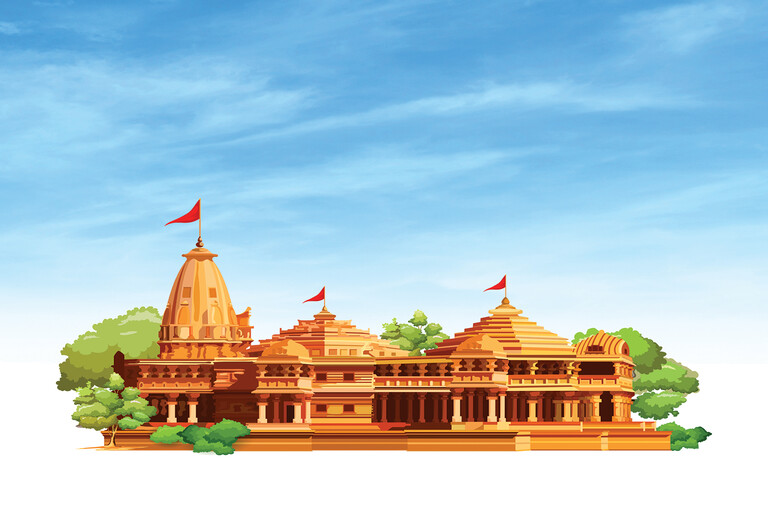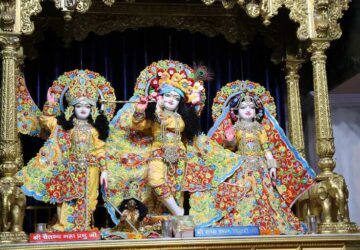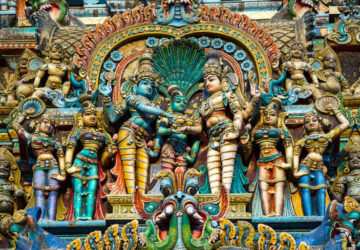
Nestled along the banks of the sacred Sarayu River in the heart of Uttar Pradesh, Ayodhya stands as a living testament to India’s rich cultural and spiritual heritage. A city steeped in history and mythology, Ayodhya is a land that take you on a journey through time, where ancient tales come to life. One of the most sacred cities in Ayodhya, it’s the perfect place to immerse yourself in the rich culture and spirituality of the place. From the popular Ayodhya Ram temple to the heritage sites, this place has it all.
In this article, we delve into the intricate details of the popular Ayodhya temples and heritage sites that you can visit on your trip.
What Makes Ayodhya A Must-Visit Destination
Ayodhya is a must-visit destination for several reasons. Apart from the famous Ayodhya temples, it’s also a place with historical significance, and cultural richness. Here are some factors that make Ayodhya a unique and interesting destination.
1. Religious Significance:
Ayodhya is considered the birthplace of Lord Rama, a central figure in Hinduism. The city is home to revered Ayodhya temples, including Ram Janmabhoomi or Ayodhya ram temple, making it a crucial pilgrimage site for millions of devotees.
2. Historical Heritage:
With a history dating back thousands of years, Ayodhya is immersed in historical significance. It has been mentioned in ancient texts, and the city’s architectural remnants and archaeological sites contribute to its rich historical heritage.
3. Cultural Vibrancy:
Ayodhya is deeply connected to India’s cultural roots through its association with the Ramayana, a significant epic in Hindu literature. The city’s lively culture shines through its festivals, traditional rituals, various forms of artistic expression and the popular Ayodhya temples like the Ayodhya ram temple or Ayodhya ram mandir
4. Architectural Marvels:
The city boasts architectural marvels like the Ram Janmabhoomi Temple, Hanuman Garhi, and other Ayodhya temples that showcase a blend of Mughal, Hindu, and other architectural styles. it provides visitors with a visual feast. One can visit the famous Ayodhya heritage sites for an immersive experience.
5. Spiritual Atmosphere:
Ayodhya’s spiritual atmosphere creates an environment perfect for meditation, reflection, and spiritual rejuvenation. Visitors often find a sense of peace and tranquillity in the sacred spaces of the city. The famous Ayodhya temples like the Ayodhya ram mandir, Hanuman Garhi and others are a sight to behold. For a spiritual experience, add the famous temples in Ayodhya to get the best out of your trip.
Best Time To Visit Ayodhya
The best time to visit Ayodhya is during the winter months from October to March when the weather is cool and pleasant. This period offers comfortable conditions for exploring the popular Ayodhya temples and heritage sites, and coincides with festivals like Diwali, enhancing the cultural experience. In contrast, the summer months from April to June can be hot, and the monsoon season from July to September brings occasional heavy rainfall. Therefore, choosing the winter season ensures an enjoyable and temperate visit, allowing travellers to fully appreciate Ayodhya’s rich cultural and spiritual heritage. Plan your visit to the famous temples in Ayodhya during this time for a hassle-free experience.
Temples in Ayodhya: Famous Ayodhya Temples and Heritage Sites
Here is a list of some of the most popular temples in Ayodhya. These Ayodhya heritage sites are unique, making your trip worthwhile.
1. Ram Janmabhoomi Temple
One of the most popular Ayodhya temples, it’s a must-visit destination in Ayodhya. The Ram Janmabhoomi holds significant religious importance as the birthplace of Lord Ram. Legend has it that Lord Ram spent his formative years along the banks of Ayodhya’s Sarayu River, making the Ram Janmabhoomi a revered site for Hindus. After decades of conflict, the Supreme Court of India allocated the Ram Janmabhoomi land to a trust for the construction of the Ram Temple. There are plenty of Uttar Pradesh tour packages that you can choose to visit the famous Ayodhya ram mandir for the best experience.
Timings: 7:00 am to 7:00 pm
2. Hanuman Garhi
Another popular temple in Ayodhya is the 10th century Hanuman Garhi temple. Located Just a short journey from Ram Janmabhoomi, this fortress-like temple is dedicated to Lord Hanuman. One of the most important Ayodhya temples, it’s customary to visit this temple before visiting the popular Ayodhya Ram Temple. Situated on a hilltop, you need to climb 76 stairs to reach the entrance. The climb to the summit, surrounded by imposing walls, adds a touch of adventure to your spiritual journey.
Timings: 5:00 am to 11 pm
3. Kanak Bhavan
Kanak Bhawan, also referred to as Sone-ka-Ghar is another famous temple in Ayodhya. Built in the year 1891, this Ayodhya ram mandir is dedicated to Lord Rama and Goddess Sita. Known as the Golden Palace, Kanak Bhawan features three idols of the deities adorned with golden crowns, sheltered under a silver roof in the sanctum. Legend has it that this Ayodhya ram mandir was bestowed upon Rama and Sita by Rama’s stepmother, Kaikeyi. It’s a must-visit Ayodhya ram mandir, so make sure to add it to your list of Ayodhya temples to visit.
How to Reach:
Timings: 8:00 am to 11:00 am
4. Treta Ke Thakur
Nestled along the serene Naya Ghat in Ayodhya, the Treta Ke Thakur Temple stands as important temples in Ayodhya. It houses an array of idols crafted from a single, rich black sandstone. Among the sacred figures enshrined within are Lord Ram, Lakshman, Sita, Bharat, Hanuman, and Sugreev. Constructed about 300 years ago by King Kullu, the temple’s foundation is said to rest upon the very ground where Lord Rama conducted the revered Ashwamedha Yagna. Centuries later, in the 1700s, the temple underwent a notable transformation under the guidance of Ahilyabai Holkar, the Maratha queen. Access to this spiritual haven is granted only once a year on the auspicious day of Ekadashi.
Timings: Opened only once a year on Kartik Shukla Ekadashi. The temple is opened for 24 hours one this day.
5. Nageshwarnath Temple
Nageshwarnath Temple stands as a beautiful temple in the heart of Ayodhya. Dedicated to Lord Shiva, this temple is believed to have been established by Kush, Lord Rama’s son. The temple was reconstructed in the year 1750 and attracts a large number of devotees throughout the year. The simplicity of the temple’s design complements the peaceful ambience, creating a space where you can reflect and connect with the spiritual essence of the place. Visit the Nageshwarnath temple, one of the most important Ayodhya temples for a spiritual experience.
Timings: 5:00 am to 8:00 pm
6. Tulsi Smarak Bhawan
Tulsi Smarak Bhawan, situated in the sacred city of Ayodhya, stands as a tribute to one of India’s most revered poets, Sant Tulsidas. This memorial house is dedicated to preserving and commemorating the life and works of the esteemed saint-poet, who played a pivotal role in shaping the cultural and spiritual landscape of India. The Bhawan, a museum and research centre, encapsulates the essence of Sant Tulsidas’s literary contributions, showcasing manuscripts, artefacts, and exhibits that offer insights into his teachings and philosophical perspectives. Visitors have the opportunity to delve into the life of Tulsidas through carefully curated displays. Devotional concerts, religious discourses and prayer meetings are also held here, making it one of the most famous Ayodhya heritage sites in Uttar Pradesh.
Timings: 10:00 am to 9:00 pm (Monday to Saturday) and 6 am to 9 pm (Sunday)
7. Sita Kund
Sita Kund holds a special place in Ayodhya’s cultural and religious landscape. This sacred pond is believed to be the bathing spot of Sita, the consort of Lord Rama. According to legend, Sita used to bathe in the pristine waters of Sita Kund during her stay in Ayodhya. Pilgrims and devotees visit this site to pay homage to Sita’s purity and to take a dip in the holy waters, which are considered to have spiritual significance. The pond is surrounded by a serene and peaceful atmosphere, making it a place for quiet contemplation and reflection. Sita Kund stands as a symbol of the enduring cultural and religious heritage associated with the epic Ramayana in Ayodhya. Visitors often find solace in the tranquil surroundings and connect with the spirituality embedded in the city’s legends and traditions.
Timings: 6:00 am to 5:00 pm
8. Bahu Begum ka Maqbara
Ayodhya heritage sites never fail to impress and the Bahu Begum Ka Maqbara stands as a beautiful site in Ayodhya. is a historical mausoleum, serving as a testament to the city’s rich cultural and architectural heritage. Constructed in memory of Bahu Begum, the wife of Nawab Shuja-ud-Daula, the mausoleum showcases striking Mughal architecture. Bahu Begum Ka Maqbara stands as an impressive structure with intricate designs, domes, and minarets. The mausoleum’s serene surroundings and well-maintained gardens add to its charm, providing a peaceful ambience for visitors. Stepping into the mausoleum, you can witness the artistic details that reflect the grandeur of Mughal craftsmanship. Bahu Begum Ka Maqbara stands not only as a memorial to a historical figure but also as one of the top Ayodhya heritage sites in Uttar Pradesh.
Ayodhya Heritage Sites: Other Attractions to Visit in Ayodhya
In addition to the well-known religious and historical sites, Ayodhya tourism invites tourists to witness several other attractions as well. Apart from the Shree Ram Mandir Ayodhya site there are some other popular Ayodhya heritage sites that you can explore on your visit.
- Sarayu River Ghats: Enjoy a serene stroll along the banks of the Sarayu River and witness the local life and rituals at the ghats. It’s a relaxing destination to visit to relax and unwind. While the Shree Ram Mandir Ayodhya site is a must-visit, the Sarayu River Ghats are also popular.
- Gulab Bari: Explore the historic garden complex of Gulab Bari, which features tombs and beautiful Mughal architecture. The place also has a great collection of roses that are beautifully grown all around.
- Ram Katha Museum: Immerse yourself in the epic of Ramayana through exhibits and sculptures at the Ram Katha Museum. The museum is home to a large collection of artefacts, terracotta, textiles, metal objects, paintings and pottery.
While the Ayodhya temples are important, these sites are also a must-visit for the best experience.
Things to Keep in Mind When Visiting Ayodhya
Here are some things to keep in mind when visiting the popular Shree Ram Mandir Ayodhya site and other important sites in Ayodhya.
- Respect Religious Sensitivities: Ayodhya is a sacred city for Hindus, and many of its sites hold religious significance. Show respect for local customs, traditions, and religious practices.
- Appropriate Attire: Wear modest clothing, especially when visiting temples and religious sites like the Ayodhya Ram Mandir. Avoid revealing or overly casual attire out of respect for the cultural and religious norms.
- Footwear Etiquette: Remove your shoes before entering temples and certain sacred sites. It’s a common practice to leave footwear outside as a sign of respect.
- Photography Guidelines: Always check for guidelines regarding photography and videography at various sites. Some places may restrict photography, particularly in inner sanctums or during religious ceremonies.
- Silence During Prayers: Maintain a respectful silence during prayer times or religious ceremonies. Avoid loud conversations or disruptive behaviour in and around religious spaces.
- Follow Temple Customs: Abide by the rules and regulations of each temple. Some temples may have specific rituals or procedures that visitors are expected to follow.
- Check Entry Requirements: Before visiting specific sites, check for any entry requirements, opening hours, and potential restrictions. Some places may have specific visiting hours or be closed on certain days.
- Stay Hydrated: Ayodhya can experience warm temperatures, especially during certain seasons. Carry water to stay hydrated, especially if you plan to explore the city on foot.
- Respect Private Properties: Some historical sites may be situated within residential areas. Be respectful of private properties and seek permission before entering if required.
- Security Measures: Follow any security measures or guidelines provided at religious sites. Security measures may include bag checks, metal detectors, and other precautions.
These were the famous temples and heritage sites in Ayodhya that are a must-visit on your trip. Each of these sites has a story of devotion, history and architectural grandeur. Each site contributes to the city’s beauty, making Ayodhya a destination that attracts not just pilgrims, but anyone seeking a glimpse into India’s rich culture and religious heritage. If you’re planning a spiritual trip to Ayodhya, consider booking your Ayodhya tour packages with SOTC. With a wide range of India tour packages to choose from, SOTC ensures a hassle-free and enjoyable experience. Book now!





Related Post
10 Famous Street Foods of Mumbai
Mount Abu: Rajasthan’s Summer Capital
15 Best Honeymoon Destinations in India in May (2024)
Get Acquainted with the Unmingled Marine life of Andamans
Ten Interesting Facts About Serbia
15 Best Places to Visit in Serbia
The Colour Coordinated Cities of Rajasthan
5 Amazing Facts about La Tomatina in Spain
Fun Facts about the World's Most Luxurious Train - Palace on Wheels
Viseisei Village –First landing